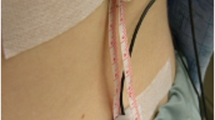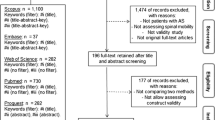Abstract
Introduction
In this paper the SpinalMouse, a new computerised external device for measuring sagittal spinal range of motion (ROM), was tested for inter-rater reliability and use in clinical practice.
Materials and methods
To assess inter-rater reliability, two investigators each measured 111 subjects.
Results
Correlation coefficients were found to be r=0.90 for flexion, r=0.85 for extension and r=0.90 for total inclination. Intra-class coefficients were 0.95 for flexion, 0.92 for extension and 0.95 for total inclination. A poor agreement (kappa=0.22) was found for the presence of outliers from normal values for intersegmental ROM.
Conclusion
We conclude the device is a useful, reliable tool for measuring sagittal spinal ROM in clinical practice, considering the small load it confers on patients and the short amount of time the measurement involves. The SpinalMouse might be more accurate after following the recommendations we make.





Similar content being viewed by others
References
Chen SP, Samo DG, Chen EH, Crampton AR, Conrad KM, Egan L, Mitton J (1997) Reliability of three lumbar sagittal motion measurement methods: surface inclinometers. J Occup Environ Med 39:217–223
Chiou WK, Lee YH, Chen WJ, Lin YH (1996) A non invasive protocol for the determination of lumbar spine mobility. Clin Biomech 11:474–480
Dillard J, Trafimow J, Andersson GB, Cronin K (1991) Motion of the lumbar spine. Reliability of two measurement techniques. Spine 16:321–324
Dodd CA, Fergusson CM, Pearcy MJ, Houghton GR (1986) Vertebral motion measured using biplanar radiography before and after Harrington rod removal for unstable thoracolumbar fractures of the spine. Spine 11:452–455
Dopf CA, Mandel SS, Geiger DF, Mayer PJ (1994) Analysis of spine motion variability using a computerized goniometer compared to physical examination. A prospective clinical study. Spine 19:586–595
Johnsson R, Selvik G, Stromqvist B, Sunden G (1990) Mobility of the lower lumbar spine after posterolateral fusion determined by roentgen stereophotogrammetric analysis. Spine 15:347–350
Keeley J, Mayer TG, Cox R, Gatchel RJ, Smith J, Mooney V (1986) Quantification of lumbar function. Part 5. Reliability of range-of-motion measures in the sagittal plane and an in vivo torso rotation measurement technique. Spine 11:31–35
Knop C, Fabian HF, Bastian L, Blauth M (2001) Late results of thoracolumbar fractures after posterior instrumentation and transpedicular bone grafting. Spine 26:88–99
Lee YH, Chiou WK, Chen WJ, Lee MY, Lin YH (1995) Predictive model of intersegmental mobility of lumbar spine in the sagittal plane from skin markers. Clin Biomech 10:413–420
Leferink VJM, Zimmerman KW, Veldhuis EFM, Vergert EM ten, Duis HJ ten (2001) Thoracolumbar spinal fractures: radiological results of transpedicular fixation combined with transpedicular cancellous bone graft and posterior fusion in 183 patients. Eur Spine J 10:517–523
Lim TH, Eck JC, An HS, McGrady LM, Harris GF, Haughton VM (1997) A noninvasive, three-dimensional spinal motion analysis method. Spine 22:1996–2000
Lindsey RW, Dick W, Nunchuck S, Zach G (1993) Residual intersegmental spinal mobility following limited pedicle fixation of thoracolumbar spine fractures with the fixateur interne. Spine 18:474–478
Madson TJ, Youdas JW, Suman VJ (1999) Reproducibility of lumbar spine range of motion measurements using the back range of motion device. J Orthop Sports Phys Ther 29:470–477
Mannion A, Troke M (1999) A comparison of two motion analysis devices used in the measurement of lumbar spinal mobility. Clin Biomech 14:612–619
Mayer RS, Chen IH, Lavender SA, Trafimow JH, Andersson GB (1995) Variance in the measurement of sagittal lumbar spine range of motion among examiners, subjects, and instruments. Spine 20:1489–1493
Mayer TG, Kondraske G, Beals SB, Gatchel RJ (1997) Spinal range of motion. Accuracy and sources of error with inclinometric measurement. Spine 22:1976–1984
Mellin G (1986) Measurement of thoracolumbar posture and mobility with a Myrin inclinometer. Spine 11:759–762
Meyers CR, Blesh TE (1962) Measurement in physical education. Ronald Press, New York
Miyasaka K, Ohmori K, Suzuki K, Inoue H (2000) Radiographic analysis of lumbar motion in relation to lumbosacral stability. Investigation of moderate and maximum motion. Spine 25:732–737
Muller R, Buttner P (1994) A critical discussion of intraclass correlation coefficients. Stat Med 13:2465–2476
Ng JK, Kippers V, Richardson CA, Parnianpour M (2001) Range of motion and lordosis of the lumbar spine: reliability of measurement and normative values. Spine 26:53–60
Portek I, Pearcy MJ, Reader GP, Mowat AG (1983) Correlation between radiographic and clinical measurement of lumbar spine movement. Br J Rheumatol 22:197–205
Post RB, Leferink VJM (2003) Sagittal range of motion after a spinal fracture; does ROM correlate with functional outcome? Eur Spine J (in press)
Schlegel JD, Smith JA, Schleusener RL (1996) Lumbar motion segment pathology adjacent to thoracolumbar, lumbar, and lumbosacral fusions. Spine 21:970–981
Shrout PE, Fleiss JL (1979) Intraclass correlations: uses in assessing rater reliability. Psychol Bull 86:420–428
Author information
Authors and Affiliations
Corresponding author
Rights and permissions
About this article
Cite this article
Post, R.B., Leferink, V.J.M. Spinal mobility: sagittal range of motion measured with the SpinalMouse, a new non-invasive device. Arch Orthop Trauma Surg 124, 187–192 (2004). https://doi.org/10.1007/s00402-004-0641-1
Received:
Published:
Issue Date:
DOI: https://doi.org/10.1007/s00402-004-0641-1




